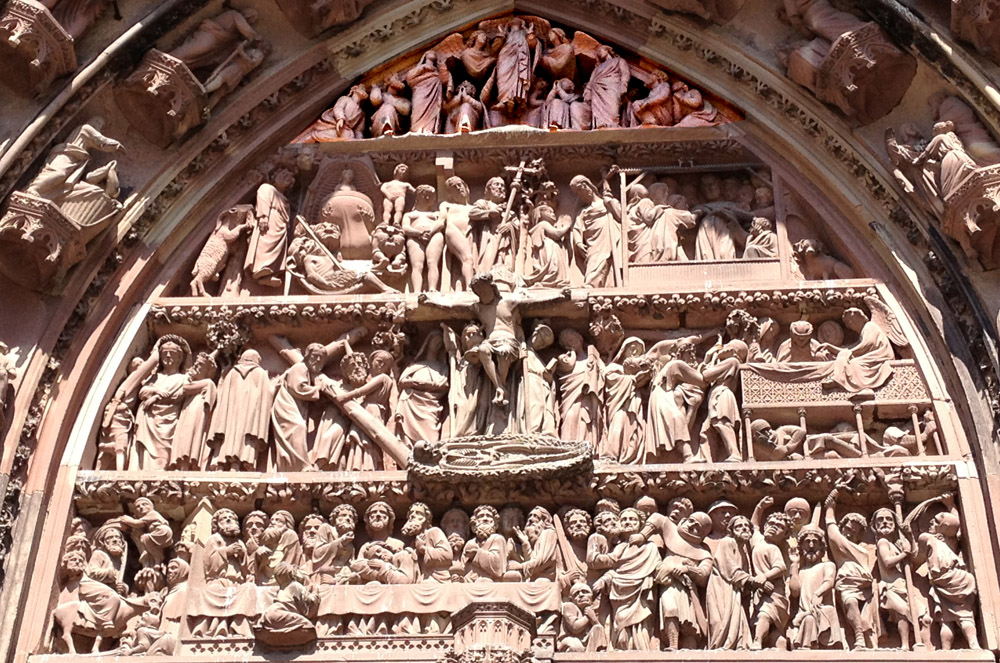Tympanum of the Passion, Resurrection, and Ascension of Christ

Cathedral of Our Lady of Strasbourg, Strasbourg, France
Center tympanum in the west façade
1280-85 (Top register reconstructed, 19th century)
This is the first Gothic tympanum to picture the Passion.1 The narrative reads from bottom to top and from left to right, many of the scenes being extraordinarily compressed.
Bottom Register
The first scene on the bottom register is Jesus' entry into Jerusalem. It includes even details that are often omitted from smaller examples. On the left three faces represent the twelve apostles. As usual, a man in a tree cuts palm branches to strew in Jesus' path. Bowing before Jesus, another man spreads out a cloak for the ass to walk on. On the right, a single figure represents the crowd that stood at the gate of Jerusalem. The gate itself functions as a divider between this scene and the next, the Last Supper. Jesus and eleven apostles sit on one side of the table while the boy with the fish reaches up from the other side. (For more on the iconography of the entry into Jerusalem, see this page, for the Last Supper see this page.)
Next Jesus is arrested when Judas kisses him. Peter's sword serves as another divider marking off the Last Supper scene. He has cut off the ear of one of the servants and Jesus is reaching down to heal it. The last two scenes are divided from each other by the exceptionally tall Jews-cap on the chief priest. To the left, Jesus is slapped for the way he has addressed the chief priest; to the right, he is scourged by Pilate's men. (For more on the iconography of the arrest, see this page. For the trials and tortures, see this page.)
Second Register
On the far left in the next register one of Pilate's men puts the crown of thorns on Jesus' head. The chief priest is the next figure, then Pilate with his back turned to the viewer, and then the carrying of the cross, with Jesus assisted by a woman and a man in a Jews-cap. The man should be Simon of Cyrene. The woman is hard to identify. Behind her is a fruit tree, a reminder of the typological correspondence between the cross and the tree whose fruit was eaten by Adam and Eve. (For more on iconography of the Way of the Cross, see this page.)
The tree also serves as a divider between this scene and the next one, the crucifixion. The cross is flanked by two pairs of figures. The outer pair comprises Mary on the left and John on the right (with his hand on his cheek, as in many Crucifixion images of this period and later). The inner pair comprises Ecclesia and Synagoga, the Church and the Synagogue. On the left Ecclesia wears a crown and her right hand carries some sort of cross or military standard; her left holds a chalice to collect the blood flowing abundantly from Jesus' side. By contrast Synagoga's right hand holds a broken scepter and her left a book of the Law, which is closed. She wears not a crown but a blindfold. (For more about this symbolism, see this section of my page on Ecclesia.)
Below the cross is a full skeleton in a sort of coffin, reflecting both the name of the hill, Golgotha, Place of the Skull, and the belief that Adam's body lay buried in that very hill. (For more on the iconography of the crucifixion, see this page.)
Another tree marks off the final scene in this register, the removal of Jesus from the cross and his burial in a tomb attended by two sleeping guards. Two women watch while a man arranges the body in the tomb, his hand guided by an angel. (For the iconography of the deposition, see this page. For the burial, see this page.)
Third Register
On the far left of the third register Judas is hanging from a tree, with a male goat climbing behind him. Remigius contrasts the meekness of a sheep with the wickedness of goats, who "climb rough and rugged rocks, and walk in dangerous places."2 Other exegetes explaining the various scriptural passages involving goats invariably interpret them negatively, usually as examples of lustfulness and "stink."3 This may explain the noticeably large sexual parts on this goat. (For the iconography of Judas, see this page.)
The rest of the left side pictures the Harrowing of Hell. With a long cross as the symbol of his authority, Jesus leads Adam, Eve, and another soul out of captivity. One woman remains behind in a pit of what looks to be fire, a detail also seen centuries later in the Chester "Descent into Hell."4 (For the iconography of the Harrowing of Hell, see this page.)
On the right side are two episodes from John's Resurrection narrative (John 20:11-18, 24-29). Each involves the touching of Jesus' body. In the scene on the left Jesus tells Mary, "Do not touch me." On the right, doubting Thomas does touch the wound in Jesus' side and recognizes him as "my Lord and my God." (For the iconography of the Resurrection see this page.)
Top register
The fourth register, placed at the top in the 19th century, completes the temporal sequence with Christ's ascension into Heaven, although one art historian has suggested that the subject of the original may have been Pentecost.5 This could explain differences from the traditional iconography of the Ascension. There is no mandorla, and Mary stands directly above her position in the crucifixion scene rather than directly below Christ. The gestures are also different. Mary is not praying, and Christ lifts his hands toward Heaven rather than blessing the viewer. (For the iconography of the Ascension, see this page.)
View this image in full resolution.
Read more about images of:
Photographed at the cathedral by Richard Stracke, shared under Attribution-NonCommercial-ShareAlike license.